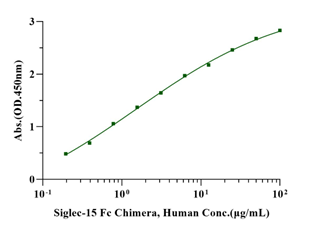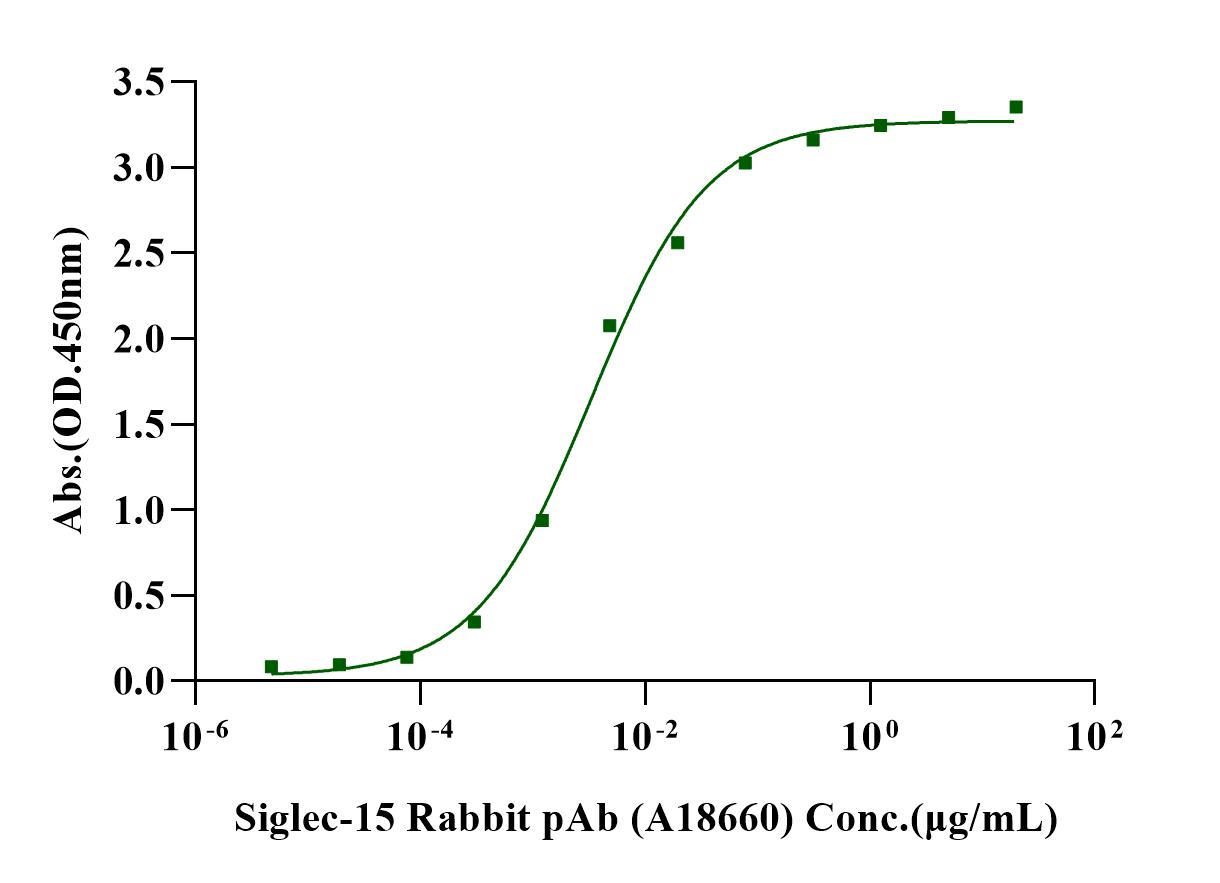Q6ZMC9-1, Phe20-Thr263 with C-terminal human IgG Fc FVRTKIDTTENLLNTEVHSSPAQRWSMQVPPEVSAEAGDAAVLPCTFTHPHRHYDGPLTAIWRAGEPYAGPQVFRCAAARGSELCQTALSLHGRFRLLGNPRRNDLSLRVERLALADDRRYFCRVEFAGDVHDRYESRHGVRLHVTAAPRIVNISVLPSPAHAFRALCTAEGEPPPALAWSGPALGNSLAAVRSPREGHGHLVTAELPALTHDGRYTCTAANSLGRSEASVYLFRFHGASGASTGGGSGGGSPKSSDKTHTCPPCPAPELLGGPSVFLFPPKPKDTLMISRTPEVTCVVVDVSHEDPEVKFNWYVDGVEVHNAKTKPREEQYNSTYRVVSVLTVLHQDWLNGKEYKCKVSNKALPAPIEKTISKAKGQPREPQVYTLPPSRDELTKNQVSLTCLVKGFYPSDIAVEWESNGQPENNYKTTPPVLDSDGSFFLYSKLTVDKSRWQQGNVFSCSVMHEALHNHYTQKSLSLSPGK
57-65 kDa(Reducing)
>95% by SDS-PAGE
Reconstitute at 0.1-1 mg/ml according to the size in ultrapure water after rapid centrifugation.
· 12 months from date of receipt, lyophilized powder stored at -20 to -80℃.
· 3 months, -20 to -80℃ under sterile conditions after reconstitution.
· 1 week, 2 to 8℃ under sterile conditions after reconstitution.
· Please avoid repeated freeze-thaw cycles.
Siglec-15 is a critical immune suppressor with broad upregulation on various cancer types and a potential target for cancer immunotherapy. Siglec-15 has unique molecular features compared with many other known checkpoint inhibitory ligands. It shows prominent expression on macrophages and cancer cells and a mutually exclusive expression with PD-L1. As a new player in the cancer immunotherapeutic arena, Siglec-15 may represent a novel class of immune inhibitors with tumor-associated expression and divergent mechanisms of action to PD-L1, with potential implications in anti-PD-1/PD-L1-resistant patients. Siglecs are cell surface proteins that bind sialic acid. They are found primarily on the surface of immune cells and are a subset of the I-type lectins. Siglec-15 consisting of immunoglobulin (Ig)-like domains, transmembrane domain and a short cytoplasmic tail. Siglec-15 is that recognizes sialylated glycans and regulates osteoclast differentiation. Siglec-15 is a potential therapeutic target for osteoporosis and plays a conserved regulatory role in the immune system of vertebrates.


Immobilized Siglec-15 Fc Chimera, Human (Cat. No. UA010059) at 10μg/mL (100μL/well) can bind Neu5Acα2-6GalNAcα-sp3-PAA-biot with EC50 of 0.33-2.60μg/ml.

Immobilized Siglec-15 Fc Chimera Protein, Human (Cat. No. UA010059) at 2.0μg/mL (100μL/well) can bind Siglec-15 Rabbit pAb (A18660) with EC50 of 2.57-4.33 ng/mL.